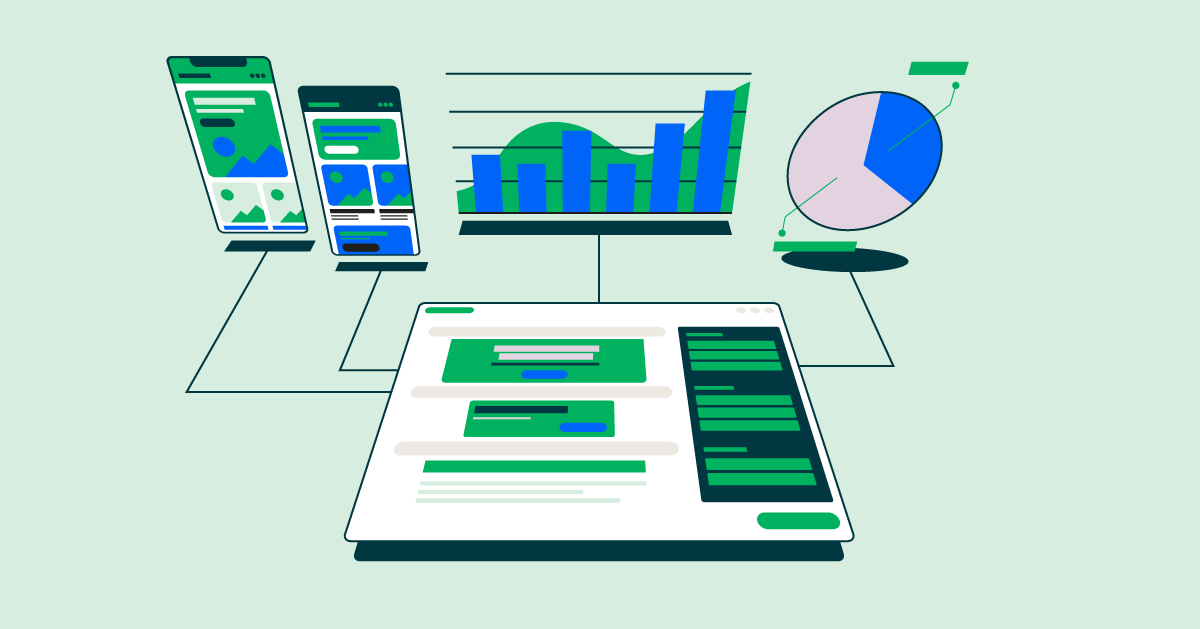Leveraging analytics and personalization in a composable DXP
The more marketing channels businesses have at their disposal, the less customers want to be treated as just another anonymous number. However, they don’t want more relevant marketing to come at the expense of protecting their personal information.
However, at the other end of that process, there’s still a marketing team that needs to handle all those content creation and management efforts. While they’re aware of customers’ expectations and the business benefits, manual personalization at scale is simply not practical.
This leaves composable digital experience platforms (DXPs) as the only answer to this problem.
Why analytics and A/B testing contribute to a better customer experience
With 80% of organizations expecting to compete mostly based on customer experience, analytics and personalization are no longer a luxury. These companies simply understand what’s at stake. According to Zendesk, over 60% of clients will switch providers after just one bad experience, up from 22% in 2022. Considering the already slim chances of businesses surviving long-term, a strategic approach toward the customer journey and user experience has become the foundation of thorough business strategies.
The problem? Companies that rely on marketing analytics for less than half of their decision-making process struggle to justify the worth of their advertising efforts.
For many marketing teams, the challenge isn’t getting useful A/B test results, but using that data to implement improvements. That’s where a composable DXP comes into play.
With many other solutions, you may have access to data, but it’s scattered across multiple platforms with different views, making it difficult to draw meaningful conclusions. A composable DXP integrates the digital experience both on your end and on the customers’. That means, you can get to your A/B tests and analytics in the same interface in which you plan your content.
Equally important, tools like Magnolia’s AI Accelerator integrate generative AI into the same interface. So not only will you understand data patterns more easily, but it’s also easier to adjust copy and images with a few simple prompts based on your data, as well as generating the personalized variants that are so hard to build at scale.
Examples of A/B testing and personalization
Let’s say your retail business sells clothing, and you’re trying to improve your customers’ experience.
A DXP like Magnolia gives you a single interface where all the data about customer preferences, browsing behavior, and purchase histories run together. You could then use that information within the same interface to personalize the shopping experience. For instance, if a client frequently buys activewear, you might showcase a special offer for your new sports collection on the home page, rather than a general overview of your catalog.
Once they decide to order, you can then track how seasonal campaigns or recent changes to copy and images affected your conversion, either through click-through rates or ecommerce statistics. This could include A/B/n tests throughout the customer journey.
Now, consider a multinational manufacturing company selling industrial machinery to businesses across the globe. A DXP could help them streamline their digital interactions with clients and partners.
For their global audience, the DXP would enable the company to manage content operations in multiple languages and even A/B testA/B test to improve the experience for different regions and demographics within those. For example, an established client in Hamburg (recognized by their browser cookies or source from a customer email) could see a pun in the local German dialect. Meanwhile, a customer in a market the manufacturer is entering just now could read it in their local language, without local references.
This level of control enables you to systematize your marketing efforts and fine-tune the experience for each individual customer to maximize conversions.
Personalize and optimize your digital experiences
Accelerate improvement with personalization, analytics and optimization without touching any code. All in one screen in Magnolia.
Metrics to benchmark across content, commerce, and personalization
There’s no one size fits all approach to ensure you track the right data. Every business will need to decide what matters for their segment, region, and goals.
For those manufacturers who also ship and sell their own products, a headless commerce platform will provide you with the flexibility to adapt to the growing expectations of clients visiting your store through various channels. At the same time, it makes it easy to scale operations independently from design choices.
By its very nature, personalization can be more difficult to track than sales, but some metrics can at least give you a sense of where you’re headed. Here are some metrics a B2B manufacturing company might track:
Repeat visitors: Analyze the frequency and patterns of visitors returning to your site. Look into what specific personalized elements or content might be encouraging patterns. For instance, track if certain personalized recommendations lead to higher revisit rates.
Number of visitors from a particular company: Dive deeper into the traffic coming from specific companies. Understand each group’s engagement patterns and which content aligns with their business needs.
Customer acquisition cost: Assess the cost-effectiveness of personalized campaigns compared to broader marketing strategies. Calculate the expenses incurred per customer acquired under each approach to refine your budget allocation.
Dwell time: Examine how long users spend on specific personalized pages to identify correlations between longer dwell times, different personalization strategies, and conversion rates.
Which assets appeal to prospects (with demographics): Analyze demographic data to determine which personalized assets resonate with different audience segments. Understand if certain demographics prefer specific types of personalized marketing or recommendations over others.
User relevance: Track click-through rates or time spent on personalized content to assess how well variants match the users’ needs and interests.
Engagement rates: Page views, dwell time, social shares, or interactions with personalized elements could inform your future strategy.
Customer, supplier, and vendor feedback: Gather feedback regarding personalized product descriptions or service customizations to refine offerings and communication with business partners.
Impact on order volume: Measure the difference in orders between clients engaging with personalized offerings and those who don’t, indicating the value derived from customization efforts.
Preference change rates: Track how effectively personalization efforts influence user responses. If browsing behavior shifts after exposure to an individualized product recommendation, it indicates successful personalization influencing their preferences.
Content longevity: Measuring the decay rate of personalized recommendations' effectiveness over time or the frequency of content updates needed to maintain relevance helps assess content longevity.
Trust and transparency index: This can involve surveys, feedback, or sentiment analyses to gauge users' trust levels in recommendations or personalized content provided by the DXP. Factors such as clear explanations for transparent data usage and privacy policies contribute to this index.
A composable platform like Magnolia can bridge the gap between your customer support, marketing, and data departments. With everyone having access to the same data dashboards and templates, developing small-scale tasks aligning with big-picture strategies is no longer a mammoth task.
How to translate your test results into a personalized experience that boosts conversions
For your data analysis to inform successful organizational decisions, you need to make continuous testing part of your routine. First, you should consider your A/B test design to ensure that the setup aligns with your business objectives. Outline what you aim to learn before running the actual test and identify key performance indicators for each variant. For instance, if the goal is to re-engage existing customers on your email list, track the conversion rate for links sent within that customer segment.
By formulating a hypothesis that directly ties to your business goals you can ensure test results actually lead to actionable strategies. You should also consider your sample size to guarantee that you analyze statistically relevant data. If you’re uncertain, study recommended practices within your niche instead of generic best practices.
Finally, don’t forget that A/B testing is an iterative process. Every time you’ve run a test, those insights should inform the next one as well as future marketing campaigns. This requires you to document your decision-making process, user feedback, and tests to look back at the details if necessary.
To follow a data-based personalization strategy, you want to set up rules for monitoring, analysis, and resulting adjustments within your DXP. That way, you don’t need to wait for the next annual report to see results. Instead, you can consistently adjust your check-ins to your goals, whether that’s a seasonal campaign or a quarterly alignment meeting.
Need more ideas for digital experience that convert? Book a demo today!
If you want to stay competitive in today’s business landscape, data-based CX strategies have to be a top priority. Developing strategies to track that information can feel overwhelming, but a composable solution like Magnolia can help you monitor digital touchpoints across marketing channels to ensure your marketing strategy is on course.
Want to see how that could work for your business? Book a demo today!









